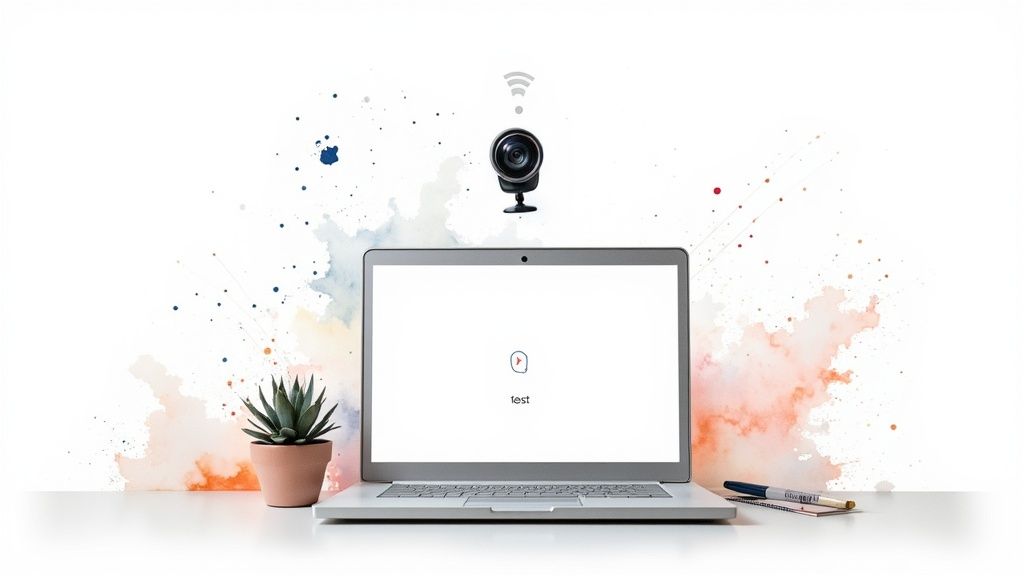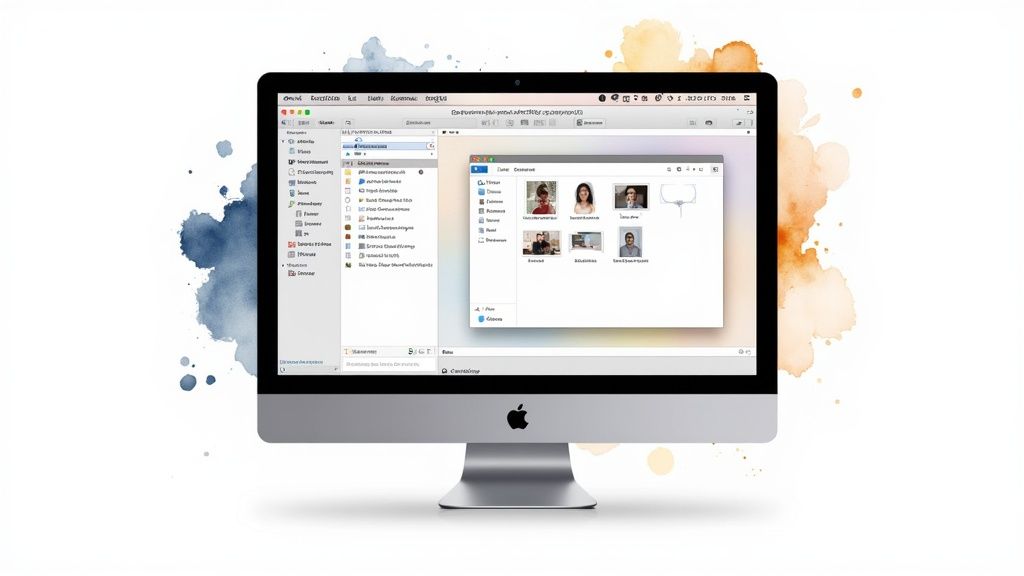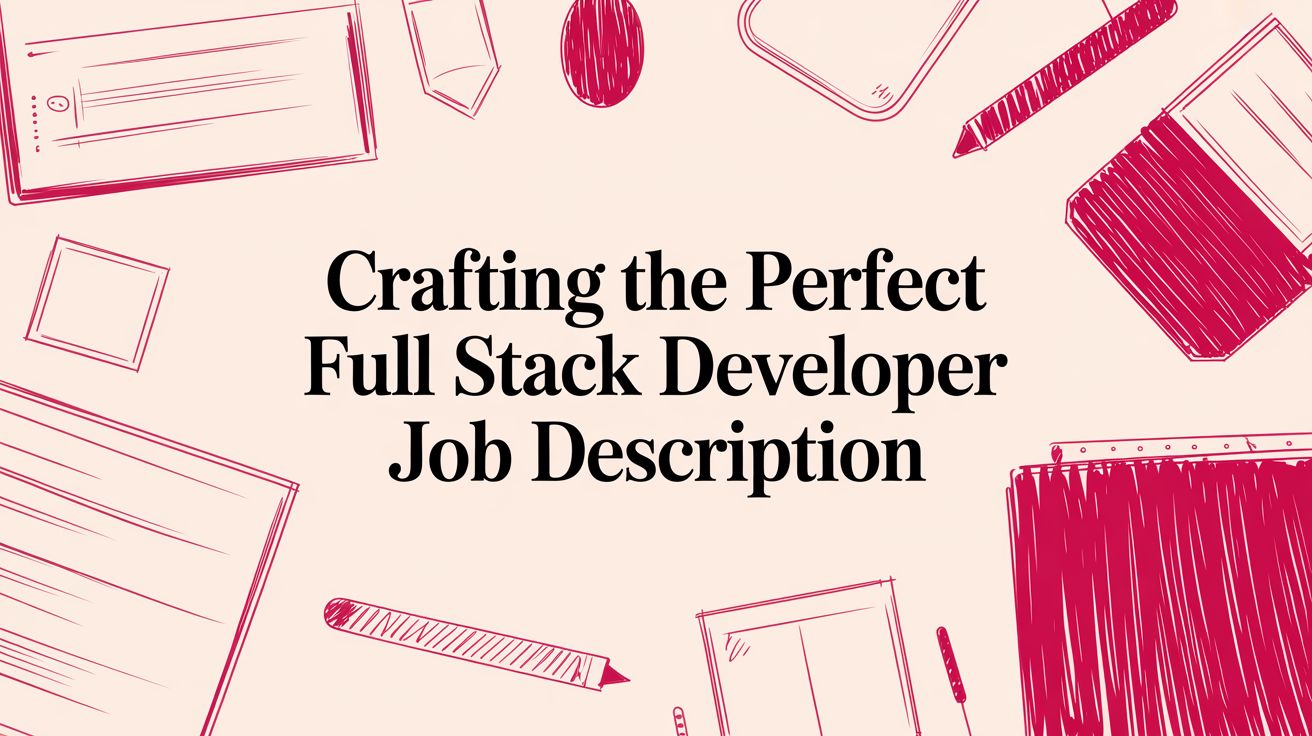8 Essential Remote Interview Tips to Master in 2025
Max
The New Handshake: Mastering First Impressions in a Virtual World
The landscape of professional hiring has fundamentally shifted. The traditional firm handshake has been replaced by the virtual call, making your digital presence the new frontier for first impressions. As remote work becomes the standard, mastering the nuances of the online interview is no longer optional, it’s a critical skill for career advancement. Securing your dream role now depends entirely on your ability to connect, communicate, and convince through a screen.
The challenge is unique: you must convey professionalism, personality, and competence without the benefit of in-person non-verbal cues. This requires a new level of preparation that goes far beyond standard interview advice. It demands a specific strategy that encompasses your technology, your environment, and your communication style.
This guide moves beyond the obvious ‘dress professionally’ advice. We provide a comprehensive, actionable roadmap with the best remote interview tips designed to transform your approach. You will learn how to build a complete system for success, ensuring you project confidence and capability in every virtual interaction.
From conducting a military-grade tech rehearsal to mastering the art of virtual eye contact and crafting a compelling digital follow-up, these insights will equip you with the skills needed to command the interview, not just participate in it. Prepare to turn your next video call into a career-defining moment.
1. Test Your Technology Before the Interview
The single most common source of anxiety before a virtual meeting is the fear of a technical failure. One of the most critical remote interview tips is to conduct a full technical rehearsal at least 24 hours in advance. This dry run moves your focus away from troubleshooting and onto what matters: showcasing your skills and personality.

Technical glitches can derail your confidence and negatively impact the interviewer’s perception of your preparedness. Creating strong first impressions is crucial, even in a virtual setting, and a seamless technical experience shows you are professional and detail-oriented. A faulty connection or poor audio quality can distract from your qualifications and make it difficult for the hiring manager to connect with you.
How to Conduct a Comprehensive Tech Check
Treat your tech setup with the same seriousness as your interview answers. Follow this checklist to ensure a smooth experience:
- Use the Native App: Always download the dedicated desktop application (Zoom, Microsoft Teams, Google Meet) instead of relying on the browser version. Native apps are more stable and offer better performance.
- Conduct a Mock Interview: Ask a friend or family member to join a test call on the same platform. Check your camera angle, lighting, microphone clarity, and background.
- Prepare a Backup Plan: Have the interviewer’s phone number or email handy. Also, save the dial-in phone number for the meeting in case your internet connection fails, allowing you to participate via audio.
- Optimize Your System: Close all unnecessary applications and browser tabs before the interview. This frees up bandwidth and processing power, reducing the risk of your computer freezing or lagging.
Learning from the Pros: Company Best Practices
Top tech companies understand the importance of a smooth virtual interview. For instance, Google often schedules 15-minute tech checks before final-round interviews, and Microsoft provides candidates with detailed technical requirements 48 hours in advance. You can emulate this by using resources like Zoom’s test meeting feature to practice on your own.
Mastering these technical aspects is a foundational step. For a more detailed walkthrough, explore our complete guide on mastering your video interview preparation.
2. Create a Professional Virtual Environment
Your physical background is just as crucial as your professional background in a remote interview. The space visible on camera is a powerful non-verbal cue that communicates your organization, seriousness, and attention to detail. Curating a professional setting is one of the most impactful remote interview tips for shaping the interviewer’s impression.

A cluttered, dark, or chaotic environment can distract the interviewer and subtly undermine your credibility. It can signal disorganization, even if you are a highly qualified candidate. Conversely, a clean, well-lit space ensures the focus remains squarely on you and your qualifications, reinforcing your professional image and helping you build a stronger connection with the hiring manager.
How to Set Up Your Interview Space
Your virtual environment should be intentional, not an afterthought. Follow this checklist to create a backdrop that enhances your presence:
- Master Your Lighting: Your primary light source, such as a window or lamp, should be in front of you, not behind you. Use a ring light or a simple desk lamp to illuminate your face and eliminate distracting shadows.
- Frame Yourself Properly: Position your camera at eye level, approximately 2-3 feet away. This creates a professional and engaging frame, ensuring you are centered and clearly visible.
- Choose a Neutral Background: A tidy bookshelf, a plain wall, or a tasteful piece of art makes an excellent backdrop. Avoid personal clutter, open doorways leading to high-traffic areas, or anything that could be distracting.
- Guarantee Privacy: Inform your family or roommates about your interview schedule to prevent interruptions. Place a note on your door and silence notifications on your phone and computer.
Learning from the Pros: Crafting a Professional Scene
Top professionals understand the power of a controlled environment. Think of BBC news anchors broadcasting from home; they use strategic lighting to create a polished, broadcast-quality appearance. Similarly, professionals on LinkedIn often recommend a simple bookshelf or a clean wall as a reliable and professional standard. You don’t need a full studio, just a thoughtful approach to what the camera sees.
These simple adjustments demonstrate that you are a serious candidate who values presentation. For more ideas on crafting the perfect long-term space, explore our complete guide to creating an optimal remote work setup.
3. Master Video Conference Etiquette
Beyond a stable connection, excelling in a remote interview requires understanding the unwritten rules of digital communication. Video conference etiquette involves specific behaviors around eye contact, body language, and speaking cadence that convey professionalism and engagement through a screen. Mastering this is one of the most impactful remote interview tips for building rapport.

In a virtual setting, non-verbal cues are easily misinterpreted. Looking at the interviewer’s face on your screen, for example, can appear as if you’re looking down and disengaged. Consciously adapting your communication style for the camera demonstrates self-awareness and respect for the interviewer’s time, reinforcing your suitability for a remote role where such skills are paramount.
How to Exhibit Professional Video Etiquette
Transform your on-screen presence from passive to powerful by actively managing how you communicate. Implement these techniques to project confidence and engagement:
- Practice ‘Camera Eye Contact’: Train yourself to look directly into your webcam lens when you speak, not at the video feed of the interviewer. This creates the crucial impression of direct eye contact with the person on the other side.
- Speak Clearly and Pace Yourself: Talk slightly slower and more deliberately than you would in person. This simple adjustment compensates for potential audio lag and prevents you from accidentally speaking over the interviewer.
- Use Purposeful Gestures: Keep your hand gestures visible within the camera’s frame to emphasize key points and convey positive energy. Avoid fidgeting or overly dramatic movements that can be distracting on screen.
- Listen Actively and Pause: Wait a brief moment after the interviewer finishes a question before you begin to answer. This small pause ensures you don’t interrupt them due to a connection delay and shows you are a thoughtful listener.
Learning from the Pros: Virtual Communication in Practice
Top organizations recognize the value of this modern skill set. For instance, companies like Salesforce actively train their global teams in effective video meeting etiquette, while prestigious institutions like Harvard Business School now integrate virtual presentation skills into their core curriculum. Even public speaking organizations like Toastmasters International offer dedicated workshops to help professionals master their virtual presence.
These practices show that strong virtual communication is a defined and valuable professional skill. To build on these fundamentals, you can find more in-depth advice in our comprehensive guide on virtual interview tips.
4. Prepare for Screen Sharing and Technical Demonstrations
In many remote roles, showing your skills is far more impactful than just talking about them. One of the most practical remote interview tips is to be ready to share your screen to showcase your work, present your portfolio, or even complete a live technical assessment. This is your opportunity to provide tangible, real-time proof of your capabilities and move beyond theoretical answers.

A seamless technical demonstration highlights more than just your job-specific skills; it reflects your organizational abilities, preparedness, and professionalism. Fumbling to find files, accidentally showing personal browser tabs, or struggling to navigate your own work can create an awkward pause that undermines the interviewer’s confidence. A smooth presentation reinforces that you are a detail-oriented and competent professional.
How to Set Up a Seamless Demonstration
Treat your digital presentation with the same care you would a physical one. Follow this checklist to ensure you are ready to showcase your work flawlessly:
- Organize Your Assets: Create a dedicated “Interview” folder on your desktop. Have all relevant links, documents, and presentations open in their respective tabs before the interview starts. This prevents awkward searching while the interviewer waits.
- Practice the Presentation Flow: Do not wait until the interview to use the screen-sharing feature. Conduct a test run with a friend on the exact platform (Zoom, Google Meet, Teams) to practice sharing the correct window or application and narrating your work.
- Have Backups Ready: Prepare both online and offline versions of your portfolio. If your portfolio website is slow to load due to a poor connection, you can instantly pivot to a saved PDF or slide deck version without missing a beat.
- Maintain a Professional Screen: Before the call, close all non-essential applications, silence notifications, and clear any personal or irrelevant browser tabs. A clean, focused digital workspace shows respect for the interviewer’s time.
Demonstrating Skills Across Different Roles
The nature of a technical demonstration varies significantly by role, so anticipate what might be asked of you. For example, a software developer may need to walk through a code repository on GitHub or solve a live coding challenge. A UX/UI designer should be prepared to present specific case studies from their portfolio website or navigate through a Figma prototype. Similarly, a data analyst might be asked to explain a dashboard they created, or a marketing professional could be tasked with showing campaign performance metrics.
5. Develop Strong Virtual Communication Skills
In a physical room, your presence, body language, and energy contribute to the conversation. On video, these signals are muted, creating a communication gap. One of the most impactful remote interview tips is to consciously adapt your communication style for the virtual stage, ensuring you project energy and build genuine rapport.
The absence of non-verbal cues means a flat delivery can be misinterpreted as disinterest or low energy. This can prevent the interviewer from connecting with you and truly appreciating your qualifications. Developing strong virtual communication skills demonstrates high emotional intelligence and adaptability, qualities that are highly valued in any remote role.
How to Enhance Your Virtual Communication
To compensate for the limitations of video, you must be more intentional with your delivery. Practice these techniques to become a more dynamic virtual communicator:
- Use Vocal Variety: Actively modulate your tone, pace, and volume. A varied vocal delivery keeps the interviewer engaged and conveys enthusiasm for the role and the conversation.
- Incorporate Strategic Pauses: A well-timed pause before a key point builds anticipation, and a pause after an important statement allows your message to land with greater impact.
- Practice Active Listening Cues: Make your engagement visible. Nod to show you are following along, smile to build warmth, and use small verbal affirmations like “I see” or “that makes sense.”
- Be Deliberately Expressive: Because cameras can flatten expressions, you may need to be slightly more animated than you would in person. A genuine smile and engaged eye contact are powerful tools.
Learning from the Pros: Observing Master Communicators
Take cues from professionals who excel at connecting through a screen. Watch how TED speakers use storytelling and vocal dynamics in virtual talks, or how news anchors maintain a direct, engaging presence with their audience. These experts show that with practice, it is possible to project charisma and build trust without being in the same room.
6. Master the Art of Virtual Eye Contact
In a traditional interview, eye contact is a natural part of building rapport. In a remote setting, however, our instinct is to watch the interviewer’s face on the screen, which from their perspective, looks like you are gazing downward. Mastering virtual eye contact means training yourself to look directly into the camera lens, creating the powerful illusion of a direct, personal connection.
This subtle shift is one of the most impactful remote interview tips for building trust and engagement. When you look at the camera, you are looking at the interviewer, conveying confidence and sincerity. This non-verbal cue helps bridge the physical distance, making your interaction feel more personal and helping you stand out as an engaged, professional candidate. It shows you understand the nuances of virtual communication.
How to Perfect Your Virtual Gaze
Developing this habit requires conscious practice. Use these actionable techniques to make camera-centric eye contact feel natural:
- Create a Visual Cue: Place a small, brightly colored sticky note or an arrow pointing to your webcam. This physical reminder will draw your eyes to the correct spot.
- Practice with Recordings: Use your computer’s video app to record yourself answering common interview questions. Watch the playback to analyze when your eyes wander and practice maintaining your gaze on the lens.
- Look at the Camera for Key Points: You don’t need to stare at the lens for the entire interview. Make it a point to look directly at the camera when you are delivering a crucial answer or making an important statement to add emphasis.
- Position Your Video Window: Shrink the video call window and move it to the top center of your screen, as close to your physical webcam as possible. This minimizes the visible distance between the lens and where you are looking.
Learning from the Pros: Real-World Examples
This technique is used constantly by professionals who communicate through a camera. Think of news anchors who build trust with their audience by speaking directly into the lens. CEOs delivering company-wide virtual addresses and online instructors engaging a classroom do the same to create a sense of presence. By adopting this practice, you are using a proven method for effective digital communication.
7. Prepare for Common Remote Interview Challenges
Despite the best preparation, unforeseen issues can arise during a virtual call. A key differentiator for a top candidate is not avoiding problems entirely, but handling them with grace and professionalism. Preparing for common remote interview challenges demonstrates your adaptability and problem-solving skills in real-time.
An interviewer understands that technology isn’t flawless. A sudden internet drop or audio lag isn’t a reflection of your qualifications, but how you react to it is. Responding with panic or frustration can leave a negative impression, while a calm, solution-oriented approach reinforces your value as a potential hire. This is one of the more advanced remote interview tips that can turn a potential disaster into a showcase of your composure.
How to Build Your Contingency Plan
Your ability to pivot when something goes wrong is a skill in itself. Create a backup plan to address the most common technical hurdles:
- Have Backup Contact Info: Keep the interviewer’s direct phone number and email in an easily accessible place, like a physical notepad next to your computer. This allows you to quickly switch to a phone call if your video or internet fails.
- Secure a Backup Internet Source: Set up your phone’s mobile hotspot and test it with your interview device beforehand. If your primary Wi-Fi goes down, you can switch over in less than a minute.
- Practice Graceful Acknowledgment: Don’t ignore a problem. Have a simple phrase ready, like, “It appears my audio is cutting out. I have your number and can call you immediately if this continues.”
- Prepare a Second Device: As a final resort, have a tablet or a second computer nearby. You can use it to quickly rejoin the meeting or check your email for a new link if your primary machine crashes.
Learning from Real-World Scenarios
Experienced hiring managers have seen it all and are typically very understanding. If a major technical failure occurs on either end, they will often be the first to suggest rescheduling. However, your proactive response, such as immediately offering to switch to a phone call, shows initiative and respect for their time. This level of preparedness extends beyond technology; it’s also crucial for handling the questions themselves. To be fully prepared, you should anticipate what they might ask by reviewing common remote job interview questions.
8. Optimize Your Digital Presence and Follow-up
Your interview does not begin and end with the video call. In a remote hiring process, your digital footprint is the first thing a recruiter often investigates, and your follow-up communication is the final impression you leave. Mastering both is one of the most impactful remote interview tips for standing out in a crowded virtual applicant pool.
A polished online presence validates the skills you claim, while a sloppy or non-existent one can raise red flags about your attention to detail. Similarly, a thoughtful follow-up email can solidify a hiring manager’s positive opinion, whereas a generic or delayed message can diminish the rapport you built. In a remote setting where in-person cues are absent, these digital touchpoints carry significantly more weight.
How to Prepare Your Digital Presence
Before the interview, ensure your online persona reflects your professional best. A comprehensive audit can make a significant difference and prevent any unwelcome surprises for the hiring team.
- Google Yourself: Conduct a search for your name to see what a potential employer will find. Address any unprofessional public content and work to elevate professional links, like your LinkedIn profile or personal portfolio website.
- Synchronize Your LinkedIn: Your LinkedIn profile should mirror your resume’s content but with expanded detail. Update your headline, add recent accomplishments to your job descriptions, and ensure your skills section is relevant to the role you are targeting.
- Prepare a Portfolio Link: Have a clean, direct link to your digital portfolio, GitHub repository, or professional website ready. You can proactively drop this in the chat if it feels appropriate or include it in your follow-up email.
How to Craft an Effective Follow-Up
Your post-interview communication is a critical opportunity to reinforce your qualifications and enthusiasm, setting you apart from other candidates.
- Send a Timely Thank-You Note: Always send a personalized thank-you email within 24 hours of the interview. This simple act of courtesy shows you are organized, considerate, and genuinely interested in the position.
- Reference Specific Details: Avoid generic templates. Mention a specific topic you enjoyed discussing or a unique challenge the interviewer described. This demonstrates active listening and helps them remember you clearly.
- Reiterate Your Interest and Value: Briefly restate your excitement for the role and connect one of your key strengths to a specific need that was discussed, making a final, compelling case for your candidacy.
8 Key Remote Interview Tips Comparison
| Item | Implementation Complexity 🔄 | Resource Requirements ⚡ | Expected Outcomes 📊 | Ideal Use Cases 💡 | Key Advantages ⭐ |
|---|---|---|---|---|---|
| Test Your Technology Before the Interview | Medium – requires tech checks & setup | Moderate – internet, devices, backup | Reliable connection; fewer tech interruptions | Any remote interview; tech-dependent environments | Reduces stress; ensures smooth tech operation |
| Create a Professional Virtual Environment | Medium – space arrangement and setup | Moderate – lighting, background, quiet | Positive impression; distraction-free space | Video interviews needing polished visual setting | Enhances professionalism; minimizes distractions |
| Master Video Conference Etiquette | Medium – behavior adjustments | Low – practice and awareness | Improved rapport; clearer communication | All video interviews focused on interpersonal skills | Builds connection; shows respect and competence |
| Prepare for Screen Sharing and Technical Demonstrations | High – tech prep and material organization | High – digital files, multiple formats | Effective demos; engaging interviewer | Technical roles requiring work demonstration | Direct skill demonstration; interactive content |
| Develop Strong Virtual Communication Skills | Medium – skill development | Low – focus on delivery style | Engaged interviewers; stronger remote connection | All remote interviews requiring impactful communication | Keeps attention; overcomes virtual barriers |
| Master the Art of Virtual Eye Contact | Medium – requires conscious effort | Low – camera positioning, practice | Builds trust; conveys confidence | Video interviews; roles needing strong presence | Creates personal connection; enhances engagement |
| Prepare for Common Remote Interview Challenges | Medium – backup planning and prep | Moderate – multiple devices and connections | Reduced disruptions; shows adaptability | High-stakes or long interviews prone to tech issues | Demonstrates problem solving; professionalism |
| Optimize Your Digital Presence and Follow-up | Medium – ongoing updates | Low to moderate – online profiles, emails | Strong professional image; increased engagement | All remote interview candidates | Reinforces professionalism; strengthens follow-up |
Your Next Chapter Starts Now: Putting Your Skills into Action
You have now moved beyond the basics of virtual interviews and are equipped with an advanced arsenal of strategies. Excelling in a remote interview is no longer just about having the right answers; it is about orchestrating a seamless, professional, and engaging virtual experience. The process itself has become a direct demonstration of your suitability for remote work. By mastering the concepts in this guide, you prove you possess the foresight, technical aptitude, and communication skills that elite remote-first companies demand.
The journey to landing a great remote role is built on a foundation of meticulous preparation. These actionable remote interview tips are your blueprint for transforming potential anxiety into confident execution, allowing your true professional value to shine through the screen.
From Theory to Practice: A Summary of Your New Toolkit
Conquering the modern interview means treating it like a professional presentation. The most critical takeaways from our guide fall into three core pillars of preparation:
Your Virtual Stage: This encompasses your technology and environment. A flawless tech check-up, from your internet connection to your microphone clarity, is non-negotiable. It signals reliability. Likewise, a curated, professional background with optimal lighting shows intentionality and respect for the interviewer’s time.
Your Digital Performance: This is about how you communicate through the lens. Mastering virtual eye contact, using deliberate and clear articulation, and projecting positive energy through engaged body language are what build crucial rapport. This is how you connect with a human on the other side of the connection, not just a camera.
Your Strategic Execution: Preparation extends to anticipating challenges. Having a plan for screen sharing, knowing how to handle a sudden technical glitch with grace, and crafting a thoughtful, impactful follow-up email all contribute to a powerful final impression.
The Differentiator: Why These Remote Interview Tips Matter
Implementing these strategies does more than just help you answer questions well; it demonstrates the core competencies of a highly effective remote employee. When you present a flawless technical setup, you are showing you are autonomous and proactive. When you communicate clearly and engage intentionally, you prove you can build strong relationships in a distributed team. These are not just interview skills; they are fundamental remote work skills.
Recruiters and hiring managers are evaluating your every move, both during the call and after. Your digital presence is a critical part of this evaluation. They will almost certainly look you up online to get a more complete picture of who you are. This is why effective digital footprint management is an essential, often overlooked, part of a modern job search. Ensuring your online persona aligns with your professional brand can be the final piece of the puzzle that secures you the offer.
Your Actionable Next Steps
Knowledge is only powerful when applied. To truly internalize these concepts, take the following steps before your next interview:
- Conduct a Full Dress Rehearsal. Don’t just test your tech alone. Call a friend or family member using the exact video conferencing tool the company will use. Practice your introduction, test screen sharing, and ask for honest feedback on your lighting, audio, and background.
- Record Yourself. Use your computer’s camera to record yourself answering three common interview questions. Watch it back and analyze your virtual eye contact, your speaking pace, and any nervous habits. Adjust accordingly.
- Create a Contingency Document. Open a document and write down your “what if” plan. What will you do if the internet drops? (e.g., “I will immediately try to rejoin; if that fails, I will email the interviewer within 2 minutes from my phone.”) This preparation calms nerves and shows you are a problem-solver.
Your preparation is now complete. You have the insights and a clear plan to stand out in a competitive remote job market. The final step is to find the right opportunities where you can put these skills to the test.
Now that you are prepared to impress, find your next great opportunity on a platform built for professionals like you. Explore thousands of vetted, high-quality remote positions without the noise and spam of traditional job boards. Start your search today on Remote First Jobs and step confidently into your next interview.


